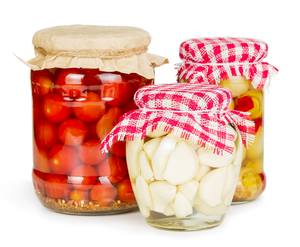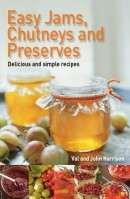This method can be used for all types of fruit and also for solid pack tomatoes.
 Pre-heat the oven to Gas Mark 2 (150°C, 300°F). Pack warm bottles with the fruit and pour in boiling syrup, brine or water allowing 1 inch (25mm) head space.
Pre-heat the oven to Gas Mark 2 (150°C, 300°F). Pack warm bottles with the fruit and pour in boiling syrup, brine or water allowing 1 inch (25mm) head space.
Place the lids on top but not the clips or screw bands. Put the bottles 2 inches (50mm) apart on a baking tray with a lip in case any liquid boils out during processing, on the centre shelf of the oven.
After the processing for the time given in the chart below, remove the bottles one at a time and secure the lids with clips or screw bands. Leave for 24 hours and test for seal.
Packing the contents in when the jars are wet will help things slide in, using your wooden spoon to pack tightly. Soft fruits should be packed as tightly as possible in layers without squashing and adding syrup or water every 4 or 5 layers.
Hard fruits may be pressed down with the handle of a wooden spoon and the syrup or water poured down the sides of the bottle gradually until it covers the fruit.
Twist the bottle from side to side and gently agitate as you add the syrup or water to remove any air bubbles.
Oven Wet Pack Bottling Chart
Timings are based on jars up to 1 quart (1 litre) size.
| Fruit | Wet Pack (mins) |
|---|---|
| Apples – in Syrup | 30-40 |
| Apples – Solid Pack | 50-60 |
| Apricots | 50-60 |
| Blackberries / Loganberries / Raspberries | 30-40 |
| Cherries | 40-50 |
| Citrus Fruits – Orange, Lemon, Grapefruit etc | 40-50 |
| Currants – Black, Red or White | 40-50 |
| Gooseberries – for cooking in pies etc | 30-40 |
| Gooseberries – for uncooked use in desserts | 40-50 |
| Peaches | 50-60 |
| Pears | 60-70 |
| Pineapple | 50-60 |
| Plums and Damsons | 45-60 |
| Rhubarb – for cooking in pies etc | 30-40 |
| Rhubarb – for uncooked use in desserts | 40-50 |
| Strawberries | 50-60 |
| Tomatoes – Solid pack | 70-80 |
| Tomatoes – in Brine | 60-70 |
Instructions for Bottling Brine for Tomatoes & Bottling Syrup are here
Instructions for checking the bottle seal
Safety of Bottled Food
One obvious risk is the seal breaking and allowing microbes access to the food. These will develop and produce gas, often leading to an increase in pressure. With commercial canned goods where the tin has been damaged, a sure sign the contents are spoiled is the can swelling. In the grocery trade, they’re known as ‘blown’.
If you open a home bottled jar and there’s a release of pressure, the food is spoiled. Usually the obnoxious smell will make this very obvious but please don’t trust the food even if it smells OK.
More On Bottling (Canning)
- Bottling or Home Canning Your Produce – Introduction, History, Safety Tips
- Equipment for Home Bottling / Canning
- Methods of Home Bottling / Canning
- Bottling or Home Canning – Preparation of Fruit and Vegetables
- Oven Dry Pack Bottling (Canning) Method
- Slow Water Bath Bottling (Canning) Method
- Fast Water Bath Bottling (Canning) Method
- Pressure Bottling (Canning)


